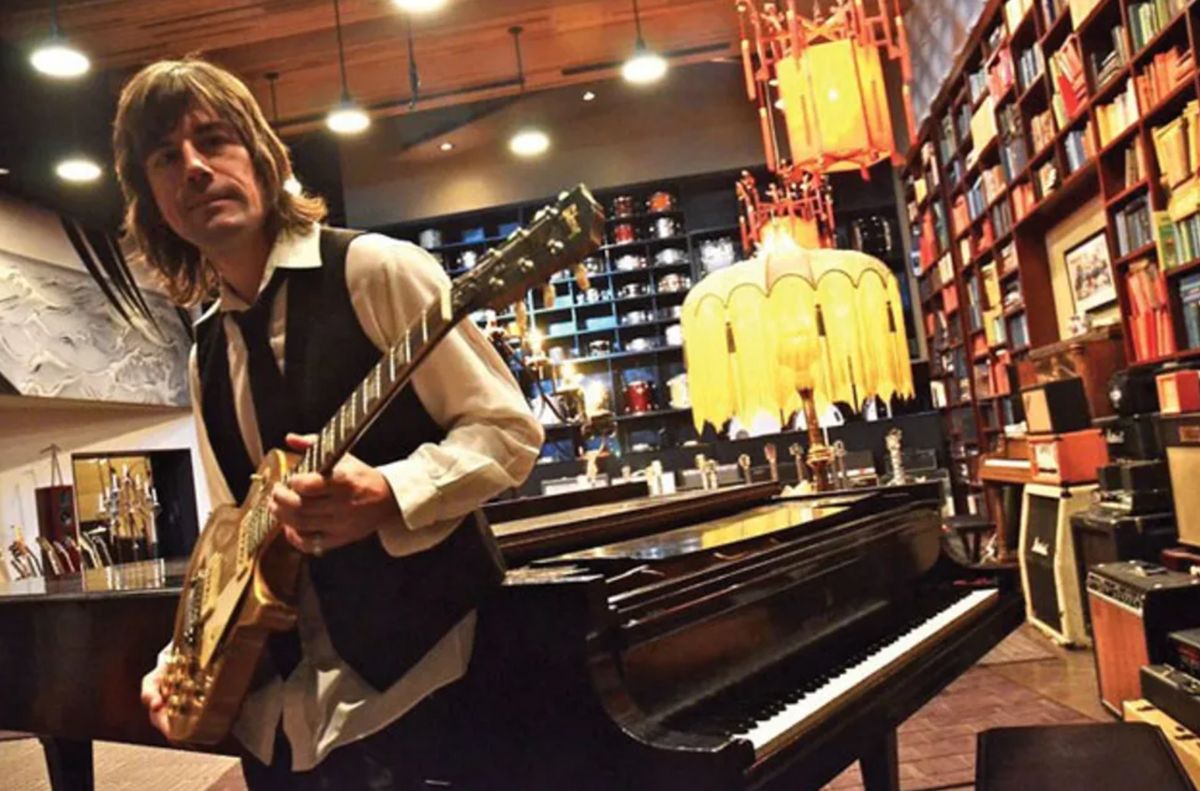
Here I am at Linda Perry's studio—Kung Fu Gardens. It's an amazing place with
a virtual treasure trove of gear options to choose from.
Turning off your ego and just rolling with the punches can yield great results.
We guitarists tend to develop a style over time. It's a combination of the musical choices we make and sounds we use, and we all just seem to gravitate towards certain gear appropriate for the style(s) we play. When we think of Stevie Ray Vaughan, a battered '60s Strat, cranked Fender and Dumble amps, and an Ibanez Tube Screamer instantly come to mind. With Hendrix, we think of Strats, Fuzz Faces, a wah, and Marshalls. And for Eddie Van Halen, it's his homemade humbucker-equipped “super strat" with a dimed Marshall plexi.
But even these iconic guitarists sometimes utilized gear that was outside the norm for them, often with outstanding results. Van Halen's use of a nylon-string guitar on “Spanish Fly" comes to mind right away. So this month I'll touch on the interesting possibilities that can come from stepping out of your comfort zone.
In 2006, I started working for producer/songwriter Linda Perry. Linda had me play on sessions for artists such as Alicia Keys, Daniel Powter, James Blunt, and many others. It was a great experience and I gained an incredible amount of insight into how to be effective in the recording studio. One of the most important lessons I learned working for Linda was that when it comes to gear, getting outside the box can yield great results creatively.
Some of you know that I'm a major gear geek, and can be quite particular about what I use. Once we get comfortable with our rigs, it can be unnerving to use gear other than our own, and I'm often adamant about wanting to use my own. But Linda really liked to suggest gear for the musicians to use when producing sessions. She has an incredible and vast collection of amps, guitars, and effects, so there was certainly no shortage of options. When I first started working for her, I'd usually bring a few guitars, amps, and a pedalboard to the studio. However I quickly realized that I could show up with nothing and be just fine.
Linda would typically have us learn a rough arrangement of the song we'd be tracking that day. I'd pick up an acoustic guitar and make a chart and notes. Once we learned the song, Linda would make decisions with each musician about what gear to use, and we'd then start setting up our rigs.
It's interesting how our musical past can affect our musical instincts when interpreting someone else's song in the studio. Linda's instincts could be totally different than mine. For example, my brain might tell me that a song absolutely needed muted eighth-notes played with a semi-dirty Les Paul/Marshall-type tone in the verses, and then opening up in the chorus. But Linda might say, “Why don't you grab the Fender electric 12-string and the Vox AC15, come up with an arpeggio part in the verses, and then do something ambient with a delay in the chorus."
The challenge was to embrace her suggestions and try to keep an open mind. That said, the most interesting and unique things often happened when I followed her instincts! When pushed out of my comfort zone both tonally and musically, I'd come up with parts that I never would have otherwise. Expanding my own musical and tonal vocabularies in the process was the truly wonderful part.
The same thing can happen in a live context, too. On many of the tours I've worked on, one member of the band usually ends up serving as the musical director, or “MD." They're like a producer because their job is essentially to make sure the band sounds great by thinking about the big picture at all times. Sometimes they ask a musician to modify a part or try something different tonally, and it's important to not take it personally when this happens.
Turning off your ego and just rolling with the punches can yield great results. Sure, you might end up playing an acoustic fingerpicking part instead of a screaming solo, but being flexible and happily trying different ideas shows you're a true professional. It can feel like you're in the hot seat when singled out in a rehearsal and asked to change something. But handling these situations with humility, grace, and a smile on your face will yield great benefits. The players who deal with these situations well are the ones who get hired over and over again.
When writing and recording my own music, I'll sometimes ask myself, “What would Linda have asked me to do here?" I often try and step out of my own preconceptions to come up with something tonally and musically unique. The great thing about music and the guitar is that there's always more to learn and somewhere else to go. See you next month for more “Tone Tips!"
- Inside a Session Gig ›
- Tal Wilkenfeld: No Limits | Premier Guitar ›
- Sweetwater Finalizes Lineup for GearFest 2020 - Premier Guitar ... ›
